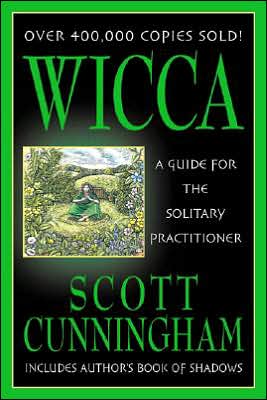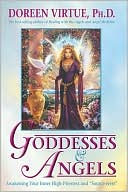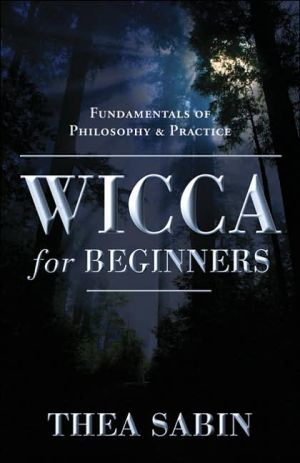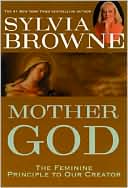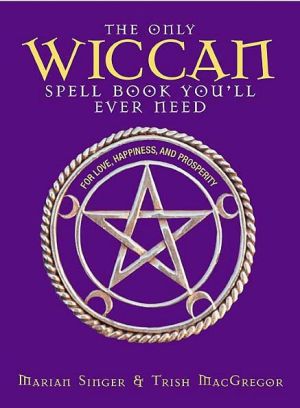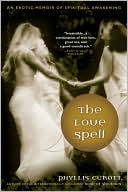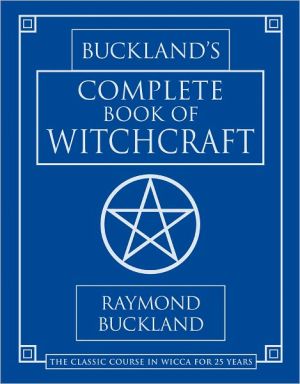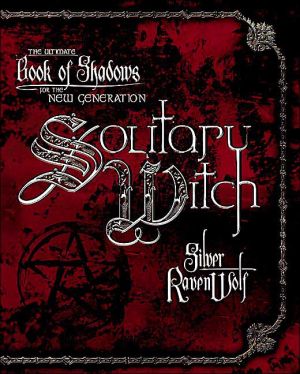Paganism: An Introduction to Earth- Centered Religions
A comprehensive guide to a growing religious movement. If you want to study Paganism in more detail, this book is the place to start. Based on a course in Paganism that the authors have taught for more than a decade, it is full of exercises, meditations, and discussion questions for group or individual study.\ This book presents the basic fundamentals of Paganism. It explores what Pagans are like; how the Pagan sacred year is arranged; what Pagans do in ritual; what magick is; and what Pagans...
Search in google:
A comprehensive guide to a growing religious movement If you want to study Paganism in more detail, this book is the place to start. Based on a course in Paganism that the authors have taught for more than a decade, it is full of exercises, meditations, and discussion questions for group or individual study. This book presents the basic fundamentals of Paganism. It explores what Pagans are like; how the Pagan sacred year is arranged; what Pagans do in ritual; what magick is; and what Pagans believe about God, worship, human nature, and ethics. ·For those who are exploring their own spirituality, or who want a good book to give to non-Pagan family and friends ·A hands-on learning tool with magickal workings, meditations, discussion questions, and journal exercises ·Offers in-depth discussion of ethics and magick Publishers Weekly Most pagan primers jump right into the seasonal calendar, Celtic strands, pentagrams, spell casting and the like. True to form, this offers a judicious overview of the calendar and the general characteristics and essentials of Paganism as the Higginbothams see it interconnectedness and blessedness. To their credit, though, the authors have crafted a very different kind of book, one of great spiritual depth that could be of genuine and lasting service to anyone who is interested in sorting out the whats and whys of belief. Early on, they outline the "big tent" of Paganism that shelters a dozen or more passageways (Wicca, Druidism, Shamanism, Santer!a, etc.), comparing it to Christianity and its popular denominations (Methodist, Roman Catholic, etc.). Throughout, they employ calm and rational prose that seeks not to proselytize as much as to aid discernment, making good on the authors' claim that, "Whether or not you decide to be a Pagan once you finish [the book] is not as important as providing you with tools to help you identify your values and goals." The seven chapters are nicely paced with illustrations, diagrams, visualization exercises, discussion points and journal prompts, all of which can be used by individuals or groups. The authors tackle the charge of Satanism head-on with success, but even more progressively (and clearly) they weave new discoveries in physics into the life fabric of belief and action. The final chapter explores ethics, and similar to the others, serves the broadest common good. (July) Copyright 2002 Cahners Business Information.
What is Paganism?\ P\ aganism, also called neo-Paganism, is a new religious movement whose adherents are found throughout the world. Paganism is an umbrella term that describes a variety of denominations—known to Pagans as traditions—which for the most part organize themselves and operate without a centralized religious body or a standardized dogma. While variety of belief and practice is a source of pride for Pagans, it can sometimes be a source of confusion for others. In the pages that follow we present what we believe to be the fundamentals of Paganism. We explore such questions as why Paganism is called an earth-centered religion, how many Pagans there might be in the United States, what Pagans are like, how the Pagan sacred year is arranged, what Pagans do in ritual, what magick is, and what Pagans believe about God, worship, human nature, and ethics.\ Over the years we have met thousands of Pagans throughout the United States. We have watched the Pagan movement grow from a fairly small, insular movement to one that may now number more than a million in the United States. We have spoken to numerous Pagans individually, participated in discussions and debates about the nature and future of the Pagan movement, and helped organize local and national Pagan events. For more than a decade we have explained and taught Paganism to many people in a variety of likely and unlikely places. We've taught Sunday school at Christian churches, given the main address at Unitarian churches, attended interfaith councils, taught world religions classes, demonstrated Pagan ritual for Mensa, given retreats, spoken at festivals and conventions, and provided newspaper, radio, and TV interviews on the subject. For most of these years we've also offered private class instruction in Paganism at beginning and intermediate levels. It is from this source of accumulated personal experience that we have collected and developed the concepts we present in this book. While elements of the topics covered here can be found in other books on Paganism, the beliefs we identify as fundamental to Paganism and how we interpret them are uniquely our own.\ We have on occasion been asked to name the most important belief or concept of Paganism. This is difficult given the many traditions within the movement. However, if we could reduce Paganism down to its essentials, we believe its two most central concepts are interconnectedness and blessedness.\ The belief that every part of the universe is profoundly interconnected shapes how Pagans view the nature of the Divine, the sorts of relationships possible with the Divine and the universe, and forms the Pagan approach to prayer and magick. Most Pagans believe that all parts of the universe, whether "animate" or "inanimate," are connected at very deep levels that extend beyond the boundaries of space-time as we know them. Because of this interconnection, many Pagans believe they are able to interact with the universe and the Divine as co-creators. This concept is further explored in chapters 5 and 6.\ The belief that every part of the universe is blessed in its nature, and that there is nothing wrong with the universe or with you, means that the purpose of Pagan spiritual practice differs from that of religions focusedon issues of purification and salvation. Paganism takes the position that human beings are unflawed in their natures, are not spiritually doomed or damned, are born with all the tools and skills necessary to live ethically and spiritually, and are naturally oriented toward their own greatest growth and development. No part of Pagan belief, practice, ritual, or sacrament is designed to "save" Pagans from a flawed or corrupt nature, or to avert supernatural punishment arising from such supposed flaws. Elements of this concept are developed throughout the book, particularly in chapter 7.\ By contrast, most world religions today teach the opposite of one or both of Paganism's central themes. They teach that the elements of the universe are separate from each other and that there is something fundamentally wrong with all of us. They may teach separateness by asserting that the universe contains distinct bits of matter not connected at deeper levels, that each of us is irretrievably separated from others and the Divine by nature, or that the universe is split between what is spiritual (and therefore good) and what is physical (and therefore bad).\ Most world religions also teach that human nature is flawed, and that there is something fundamentally wrong with all human beings that must be corrected in order to reach that religion's idea of salvation or enlightenment. This wrongness may be called original sin or ego or desire or free will or any other of a number of names, but the existence and overcoming of this inherent wrongness is the basis of the spiritual practices, sacraments, and ethics practiced by their members. In such religions, the wrongness frequently doesn't end with human beings but extends into the entire physical world so that we are seen to be surrounded by wrongness, to be spiritually unsafe, and are encouraged to feel that life is a very dangerous undertaking. The concepts of separateness and wrongness are so ingrained in each one us and in our culture that most of us are often not even aware they color our perceptions, life experience, and spiritual growth.\ Paganism soundly rejects both of these concepts, and unequivocally affirms the interconnectedness of all parts of the universe and the inherent rightness or blessedness of the universe and human nature. Certainly Pagans believe that humanity can improve itself, but Pagans do not equate the human ability to make bad choices with a flawed nature.\ Joyce and I believe that the concepts of interconnectedness and blessedness are what link together most of the divergent paths and traditions within Paganism. Yet they are not the only common threads Pagans share, as you shall see throughout this book. However, if you come away from here with no other knowledge of Paganism than the concepts of interconnectedness and blessedness and what Pagans mean by them, then you will have gained something of value.\ General Characteristics of Paganism\ In addition to the two central themes of interconnectedness and blessedness, what other characteristics common to Paganism as a whole can we identify?\ Paganism is a religion. As in other religions, Pagans seek answers to ultimate questions such as what is the meaning of life, what happens after death, is there a God, what is our basic nature, and how do we interact with the greater universe. Pagans seek these answers in the context of a religious and social community. Pagans gather in churches, homes, or outdoors, and meet in groups that may be called, among other things, circles, covens, churches, or groves. Unlike members of some religions, however, Pagans generally do not actively proselytize. They do not send out missionaries, hold revivals, or try to gain converts. Almost none of the Pagans we know "converted" to Paganism in the traditional sense. They became Pagan by deciding that Paganism reflected what they already believed and then adopted the word "Pagan" to describe themselves.\ Like other religions, Pagans have clergy who perform religious functions such as marriages and funerals. Pagans also observe a sacred year and have religious holidays and other celebrations. Most modern Pagan traditions are described as "earth-centered." Pagan holidays often fall on dates that mark the change of seasons or are otherwise seasonally important. We take a look at the Pagan sacred year and how it is celebrated later in this chapter.\ Paganism is a modern religion. Paganism is a new religion, even though it may borrow concepts and practices from any spirituality, including those now fading or extinct. Paganism is classified as a new religion by social scientists who report that Paganism exhibits all six features of new religious movements. These are (1) a pronounced religious individualism, (2) an emphasis on experience instead of belief and doctrine, (3) a practical perspective on matters of authority and practice, (4) an acceptance and tolerance of other religions and worldviews in general, (5) a holistic worldview, and (6) an open, flexible organizational framework.1\ Pagan traditions also meet the test of a religion as applied by the U.S. courts. Characteristics that courts look for include historic longevity, number of devotees, the existence of clergy, religious literature, ceremonies, and holidays. The federal courts correctly recognized Wicca, the largest of the Pagan traditions, as a religion in the case of Dettmer v. Landon (1986).2 In this case, the court found that Wicca exhibits the characteristics of a religion as outlined above.\ Paganism has no central hierarchy or dogma. Paganism is a religion that as a whole has no central hierarchy or dogma, though individual traditions may adopt an internal governing structure and specific beliefs. Some Pagan paths have a specific ethnic focus, such as the Asatru, African, and Celtic Traditionalists. Others pull together many Pagan and non-Pagan religious beliefs and practices and blend them into a unique religious expression, such as the Eclectic and Blended paths. (We look at a variety of these traditions later in the chapter.) Most Pagans enjoy spiritual diversity and would not think it appropriate for all Pagans to believe the same things, practice in the same ways, or be organized under the same structure.\ Paganism stresses personal responsibility. Most Pagan traditions stress personal responsibility and put the burden of developing spiritual practices, beliefs, and ethics on to the individual. Even those traditions that offer established beliefs and methods encourage their members to test ideas so that members build the mental muscles necessary to judge the soundness of beliefs for themselves. Those traditions that offer established moral guidelines also tend to encourage their members to explore ethical ideas so that members can find their own ethical sense and formtheir consciences accordingly. With this freedom comes a corresponding responsibility; a responsibility for one's beliefs, behavior, and degree of spiritual development. As friend and fellow author Dana Eilers once humorously observed to us, "Some religions are a restaurant. You sit down and they bring you what they're serving for dinner. Paganism is a buffet. If you want to eat, you have to get up off your butt and serve yourself."\ On the whole, Paganism's approach to the issue of personal responsibility is very empowering for the individual. It is also empowering for the greater society as the number of mature and self-directed individuals in it increases.\ Paganism offers a different worldview. Paganism is one of the first religions that deliberately incorporates new perspectives from science, metaphysics, and mysticism into its spirituality and consciously breaks from the traditional Newtonian view of the world. (These concepts are explored further in chapter 5.) Pagans tend to see all parts of the universe—from the smallest atom to the largest planetary system—as sacred and having some form of consciousness or spark of intelligence. Most Pagans believe that this living universe is able to communicate to all parts of itself on one or more levels, and that these parts can choose to cooperate together for specific ends. Pagans call this cooperation magick.\ Paganism is a spirituality. Paganism is a way of living, praying, and connecting to the flow of the universe. Pagan spirituality addresses the existence and nature of Deity, the relationship of ourselves and the universe with the Divine, the nature and scope of human existence, what happens to us after death, the nature of the physical and nonphysical universe, and our relationship to that universe. Spiritual practices among Pagans are quite varied and include everything from formal ritual to meditation, quiet walks, singing, dancing, healing, divination, ecstatic sex, working with herbs, gardening, and massage. Just about any activity can be incorporated by a Pagan into his or her spirituality.\ Paganism is protected by law. The freedom to hold and practice the religion of one's choice is a hallmark of liberty in the United States as well as several other countries. It is a right enjoyed by American citizens regardless of their affiliation as a liberal, conservative, Democrat, or Republican. President George W. Bush, a Republican conservative, stated in a speech given to a joint session of Congress on September 20, 2001, following terrorist attacks against the United States that, "No one should be singled out for unfair treatment or unkind words because of their ethnic background or religious faith." He also pointed out that if the citizens of the United States intend to defend their principles, then their "first responsibility is to live by them." Paganism is protected in the United States under the First Amendment and various civil rights acts. One of the largest of the Pagan traditions, Wicca, is formally recognized as a religion in the case of Dettmer v. Landon, as mentioned earlier. Pagans in the military are allowed to practice their religion on military bases, as are Christians, Buddhists, Jews, Muslims, and Hindus.\ What Does "Pagan" Mean?\ The word Pagan comes from the Latin word paganus, which means "country dweller." It may have been a derogatory term created by city dwellers to describe "thosehicks out there," much like the word "redneck." Because "pagan" tended to have a negative meaning, it was later adopted as an insult.3 During the Crusades, the Christians called the Muslims "pagans," and later, Protestants and Catholics flung the word at each other.4 Eventually, "being pagan" meant someone without religion.5\ Since the word "Pagan" has been adopted by the Pagan movement, some of its perceived stigma has lessened. At the very least, the word helps us to think about the labels history applies to those who differ from conventional Western thought. Some Pagans don't like the word and use other terms to describe their path, such as African Traditional Religion, Native Spirituality, Celtic Spirituality, Heathenry, Earth-Centered Spirituality, European Traditional Spirituality, the Elder Faith, and the Old Religion.\ Joyce and I occasionally run into Pagans having a debate over whether the term "Pagan" or "neo-Pagan" should be used. The term "Pagan," after all, refers to ancient, tribal, and usually pre-Christian cultures that are mostly extinct. To avoid confusion between historical Paganism and the modern movement, many social scientists and Pagans alike have decided they prefer the word "neo-Pagan."\ The noted author and Druid Isaac Bonewits goes further. He uses the word "paleopaganism" to describe "the original tribal faiths of Europe, Africa, Asia, the Americas, Oceania and Australia." A few of these tribal faiths, such as Hinduism, Taoism, and Shintoism, whose adherents number in the millions, have survived to the present. Next, Bonewits describes "mesopaganism" as re-creations of paleopagan systems, usually with influences from Judeo-Christian thought. Some of his examples are Freemasonry, Rosicrucianism, Theosophy, Voudon, Santeria, and Sikhism. His third category is "neopaganism," which he defines as religions created from the 1960s onward, and that "have attempted to blend what their founders perceived as the best aspects of different types of paleopaganism with modern 'Aquarian Age' ideals." 6\ We leave it to you to decide how to refer to your spiritual path. In this book, however, we use the word "Pagan."\ Who Is a Pagan?\ The word "Pagan" is a label that identifies you as a person who agrees with one or more parts of Pagan philosophy, and who may participate in observances or practices common to Pagans. In the broadest sense, Paganism is an umbrella term that describes a multitude of religious and spiritual traditions. This is not unique to Paganism. Most of us are already familiar with Christianity as an umbrella term that describes a myriad of denominations and groups. These include Methodists, Catholics, Baptists, Mormons, Episcopalians, Presbyterians, and Jehovah's Witnesses, to name a few. If we try to define Christianity in a sentence we will find it difficult. Moreover, we will not be able to capture in that sentence the differences between Catholics and Mormons, for example. Pagans are in the same boat, and yet are frequently asked by friends, family, and journalists to describe all of Paganism in a sentence or a sound bite.\ Let's take a look at the Pagan umbrella (Figure 1.1). Under Paganism's umbrella are found such diverse traditions as Wicca, Shamanism, Asatru, Eclectic, Family Traditions, Celtic Traditionalism, Druidism, Strega, Santeria, Voudon, Ceremonial Magick, Mystery Traditions, solitaries, as well as a wide variety of Blended paths such as Judeopaganism, Christopaganism, Buddhistpaganism (or Easternpaganism), and so on. These traditions, while spanning many centuries and cultures, share at least one of several characteristics: they are indigenous, earth-centered, contain magickal elements, recognize both male and female deities, were suppressed or eradicated by another religion, or stress a connection to and respect for the natural world.\ In other words, Paganism is a broad term that acts as an umbrella under which many different traditions find a home. Joyce and I have been asked, "So are you Wiccan or are you Pagan?" This like asking, "So are you Baptist or are you Christian?" Wiccans are Pagans, but not all Pagans follow a Wiccan path, in the same way that Baptists are Christians, but not all Christians are Baptists. To answer the question of what Joyce and I are, we would reply that we are "Eclectics." What does that mean exactly? Below we take a brief look at each of the Pagan traditions. Unfortunately, it is beyond the scope of this chapter to explain the various traditions in detail. The study of even one tradition can, and does, fill many books. So many books, in fact, have been written on most of these paths and traditions that you should have no trouble finding further reading. Just check with your bookseller by subject.\ Wicca. Wicca is the single largest tradition within Paganism; nearly half of all Pagans are Wiccan.7 Wiccans follow an earth-centered calendar of eight festivals a year, and believe that Deity manifests in both male and female forms often called "the God" and "the Goddess." The Wiccan ethic is set out in the Wiccan Rede, which states, "If it harm none, do what you will."\ Gardnerian Wicca. This is the name given to the branch of Wicca begun by Gerald Gardner in 1939.\ Alexandrian Wicca. This is an adaptation of the Gardnerian tradition. It was begun by two of Gardner's students—Alex and Maxine Sanders—during the 1960s. Both Gardnerian and Alexandrian traditions tend to use set ritual forms and more hierarchical degrees of training than other forms of Wicca.\ Dianic Wicca. This is a Wiccan path that focuses on the strong female Deity Diana. Dianic groups often allow only women members and may concentrate only on Goddess energy. Specifically, they work with the images of Goddess as maiden, mother, and crone, known as the Triple Goddess. The term "Dianic" was first used by Margaret Murray, author of The Witch-Cult in Western Europe in 1921.8\ Faery Wicca. Those who practice Faery Wicca work specifically with nature spirits.\ Strega. This is an Italian tradition of Wicca that emphasizes herbal knowledge and tends to be strongly matriarchal.\ Shamanism. Shamanism is a Pagan tradition that involves going into a trance state in order to perform a variety of works, which may include healing and divination. Shamanism is considered by some to be the oldest Pagan tradition.9 It is also found in cultures and religions not necessarily considered Pagan. The shamanic Pagans we know may follow a particular shamanic tradition or combine practices from several; they do not necessarily use Wiccan techniques such as casting a circle, calling the directions, and inviting Deities, although they might if they consider themselves Shamanic Wiccans.\ Asatru. Those who practice Asatru devote themselves to the Nordic, Germanic, and Icelandic Deities, and may do soto the exclusion of all other Deities by a voluntary covenant.\ Eclectic. Those who practice Eclectic Paganism combine what they believe to be the best elements from a variety of Pagan, and possibly non-Pagan, traditions.\ Family Traditions. This Pagan tradition involves beliefs and practices that are passed down through a family over the generations. The practice of the tradition may be informal and involve no ritual, but its origins are frequently Pagan. The connection to Paganism may be downplayed, denied, or combined with Christian elements. A well-known surviving example is the Germanic Pow-wow tradition, which has its origins in German witchcraft and has been modified into faith healing.10\ Celtic Traditionalism. This describes groups, or clannads, whose goal is to re-create pre-Christian Gaelic religion and society.\ Druidism. Druidism is a revival tradition that attempts to re-create the Druidic system and may or may not be combined with Celtic Traditionalism. Since the Druids left few written records of their practices and rituals, modern Druidism tries to infer what was done.\ Santeria and Voudon. These are traditions that developed among Africans, especially followers of the Yoruban religion, which later spread into Central and South America. Voudon is based in Haiti, and Santeria in Central America, South America, Puerto Rico, and some portions of North America. As was mentioned earlier, Isaac Bonewits describes Santeria and Voudon as "mesopagan" traditions. Many, though not all, of the Pagans we know who combine aspects of Santeria, Voudon, or Yoruba into their spirituality are ethnically connected to these cultures and have frequently told us that their study of these "mesopagan" faiths brings them closer to their cultural origins.\ Ceremonial Magick. This describes traditions that usually involve precise rituals, words, and tools, and draw heavily on the writings of Aleister Crowley and the Order of the Golden Dawn. The Golden Dawn was a prominent occult society founded in Britain in 1887 by a small group of Rosicrucians. Its complex set of rituals are set out in the book The Golden Dawn by Israel Regardie. Ritual magicians who focus on Crowley's works and ritual forms are known as Thelemics.\ Mystery Traditions. This Pagan tradition includes those who study the ancient Greek, Roman, or Egyptian Mystery Traditions, particularly those practiced between three and five thousand years ago.\ Solitary. This term describes a person who practices alone, regardless of tradition. This does not mean that solitaries never enjoy being with a group or community of Pagans. We know many solitaries who attend public Pagan functions in our city. They do not, however, have an interest in joining a circle or coven on a permanent basis.\ Blended Traditions. This term describes traditions that deliberately blend together two paths. Examples include Judeopaganism, which is often strongly matriarchal and blends certain ancient Jewish customs with an earth-centered practice. We have a friend who calls herself a "Jewitch," for example. Christopaganism blends some Christian beliefs and practices with Paganism. Christopagans may pray the rosary and work magickally with angels, archangels, and other spirits. In our experience, most Christopagans revere Jesus and believe that his teachings are loving and beneficial to the world and are in no way in opposition to the principles of Paganism.We have also met Pagans who blend some aspects of Buddhism and other Eastern traditions into their spiritualities. In addition to Pagan observances, their spiritual practices may include periods of meditation, yoga, tai chi, or the martial arts.\ How Many Pagans Are There?\ Since there are no membership lists, getting a head count of Pagans is a challenge. Modern efforts to document Pagans began in Britain in the 1950s during a revival of interest in Paganism. The revival was encouraged by the repeal of the antiwitchcraft laws in England in 1951 and the publication of Gerald Gardner's book Witchcraft Today.11 At that time, the number of Pagans in the United States was probably low, but no records were kept. The British revival grew and by the 1960s Paganism had become fairly popular in the United States. However, the emergence of a sizable Pagan presence in the U.S. did not occur until the 1970s, and was aided by the publication of two books, Margot Adler's Drawing Down the Moon and Starhawk's Spiral Dance, both of which are still popular today.\ One of the earliest scholarly studies of Paganism was conducted by Marcello Truzzi in 1972. At that time he estimated Wiccans to number 3,000 in the United States, but gave no data on the number of Pagans as a whole.12 Based on data collected in the mid-1980s, religious academics in the early 1990s estimated the number of Pagans in the United States to be approximately 300,000, a rather remarkable rate of growth in one decade.13 The mid-1980s population numbers were generated by the analysis of book sales, attendance at Pagan festivals, and studies of group membership patterns.\ How many Pagans are there now? Unfortunately, there has been no population data collected by religious academics since the mid-1980s. Informal data can be found in polls and surveys, however, and these offer some food for thought. The website Survey.net conducts an ongoing religious survey for Internet users. Their survey includes categories such as Wicca, Druid, Faery, Old Gods, New Age, Ceremonial Magick, and Goddess Traditions. Near the beginning of 2002, 6.5 percent of Internet users who responded to the survey identified themselves as belonging to one of these categories.14 In September 2001, the United States government conducted a study in which it determined that Internet users in the U.S. numbered 143 million people.15 If we extrapolate the Internet survey percentage to U.S. Internet users as a whole, then as many as 9.3 million Internet users may be Pagan, or follow paths closely related to Paganism.\ Another interesting figure comes from the Hart and Teeter Research Companies. The organization conducted a poll in October 1997 in which 4 percent of respondents answered they are involved in an "alternative religion." 16 Although Pagans often refer to their spirituality as an "alternative religion," the term would obviously include many religions other than Paganism. Even so, it is interesting that such a large percentage of the population, or approximately 10.8 million people if we extrapolate the survey percentage to the U.S. population as a whole, identify their spirituality as "alternative."\ Along these same lines, a survey conducted in 1995 by Yankelovich Partners reveals that 8 percent of those polled had participated in "New Age" rituals and practices such as contacting the dead, spirit channeling, investigating past lives, mental telepathy, healing through mind power or crystals, consulting a fortuneteller or astrologer, or making plans based on their horoscope.17 This survey includes practices that are not exclusively Pagan. However, if we apply the survey percentage of 8 percent to the U.S. population as a whole, then it does indicate that 21.6 million people were apparently open enough to New Age, Pagan, and other alternative practices to participate in them.\ We discussed the issue of Pagan population figures with a religious academic who has published studies on Paganism, and he believes that at the beginning of the twenty-first-century Pagans in the U.S. numbered about 1.25 million people. This is just his opinion, however. We will have to wait for another academic study to be released before we will know if he was correct.\ How do the number of Pagans compare to other religions in the United States? According to 2002 World Almanac figures for "northern America," which excludes Latin America and South America, Buddhists number just under 800,000, Hindus 1.3 million, Jews number 6 million, and Muslims number about 4.5 million. Even using the mid-1980s Pagan population figure of 300,000, Pagans constitute a significant minority. If future academic studies support the estimate of one million or more Pagans, then Pagans would indeed constitute a significant religious minority in the United States as of the turn of the twenty-first century.
ContentsAcknowledgments / xiIntroduction / xiii1 What is Paganism? 1General Characteristics of Paganism / 3What Does "Pagan" Mean? / 6Who Is a Pagan? / 7How Many Pagans Are There? / 12Where Pagans Come From and What They"re Like / 13What Pagans Do and When They Do It / 15An Earth-Centered Religion / 16The Wheel of the Year / 16Rites of Passage / 25What Is a Ritual? / 30What Happens in a Ritual? / 30Ritual Tools and Symbols / 33Is Ritual All Pagans Do? / 38What Do Pagans Believe? / 38Principles of Paganism / 392 You Are What You Believe 45How Do Beliefs Work? / 46What Is a Belief System? / 54Claiming the Power to Choose Your Beliefs / 58Search: Paganism"s Spiritual Foundation / 663 A Pagan View of deity 75Concepts of Deity / 78What Do Pagans Believe About Deity? / 79The God Map / 80A God Map Story / 924 What About Satan? 101How Do Pagans View Satan? / 102Pagans, Witches, and Bad Reputations / 103Why Witch-hunts? / 106What Happened to the Accused? / 108A Look at the Biblical Witch Bias / 108A Fabricated Image / 109The Social Roles of Satan / 111The Mythological Roles of Satan / 113Who Is a Satanist? / 120Can a Satanist Be a Pagan? / 1215 The Living Universe 131The Current Western Mindset / 132Unbroken Wholeness: Science and a Magickal Universe / 135The Ground of Being: Mysticism and a Magickal Universe / 145The Universe as a Cosmic TV / 155Personal Experience and a Magickal Universe / 1616 Magick 163The Mechanics of Magick / 165The Iceberg / 172The Applications of Magick / 179The Limitations of Magick / 184Your Magickal Pager / 1877 Ethics and Personal Responsibility 197Who Are You? / 197The Multidimensional Self / 199The Afterlife / 201Ethics: What Are They? / 206The Western Religious Ethic / 207Ethics: The Pagan Approach / 210Pagan Ethical Systems / 214Notes / 225Glossary / 231Bibliography / 235Recommended Reading / 239Index / 245
\ Publishers WeeklyMost pagan primers jump right into the seasonal calendar, Celtic strands, pentagrams, spell casting and the like. True to form, this offers a judicious overview of the calendar and the general characteristics and essentials of Paganism as the Higginbothams see it interconnectedness and blessedness. To their credit, though, the authors have crafted a very different kind of book, one of great spiritual depth that could be of genuine and lasting service to anyone who is interested in sorting out the whats and whys of belief. Early on, they outline the "big tent" of Paganism that shelters a dozen or more passageways (Wicca, Druidism, Shamanism, Santer!a, etc.), comparing it to Christianity and its popular denominations (Methodist, Roman Catholic, etc.). Throughout, they employ calm and rational prose that seeks not to proselytize as much as to aid discernment, making good on the authors' claim that, "Whether or not you decide to be a Pagan once you finish [the book] is not as important as providing you with tools to help you identify your values and goals." The seven chapters are nicely paced with illustrations, diagrams, visualization exercises, discussion points and journal prompts, all of which can be used by individuals or groups. The authors tackle the charge of Satanism head-on with success, but even more progressively (and clearly) they weave new discoveries in physics into the life fabric of belief and action. The final chapter explores ethics, and similar to the others, serves the broadest common good. (July) Copyright 2002 Cahners Business Information.\ \ \ \ \ Library JournalThe founders of both a pagan church and the Council for Alternative Spiritual Traditions, the Higginbothams here offer an overview of the belief systems comprising neopaganism. Included in the discussion are Wicca, Shamanism, Asatru, Celtic traditionalism, Druidism, Santeria, Voodoo, and other forms prevalent in paganism today. The authors proceed from central concepts of interconnectedness and blessedness, to a definition of neopaganism and a discussion of personal responsibility for one's beliefs, to concepts of Deity, Satan, the living universe, "magick," and ethics. The format is similar to that of many self-help books, with text, diagrams, discussion questions, and meditation exercises. This clear, rational, and sympathetic introduction to neopaganism for nonpagans will be helpful to all readers interested in exploring their spirituality. This first book by the Higginbothams complements existing introductions, such as Margot Adler's Drawing Down the Moon and Graham Harvey's Contemporary Paganism: Listening People, Speaking Earth, at least one of which libraries should already have. Recommended for public and undergraduate libraries and for religion collections. William P. Collins, Library of Congress Copyright 2002 Cahners Business Information.\ \

